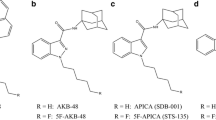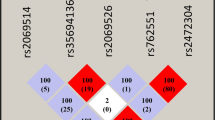Abstract
We recently reported that Δ9-tetrahydrocannabinol (Δ9-THC), the primary psychoactive constituent in marijuana, potently inhibits the catalytic activity of cytochrome P450 (CYP) 2C9.1, a wild-type variant. However, effects of CYP2C9 genetic polymorphisms on the inhibitory potency of Δ9-THC have not been investigated. In this study, in vitro inhibitory effects of Δ9-THC on catalytic activities of two major allelic variants, CYP2C9.2 and CYP2C9.3, were examined with the recombinant enzymes. Δ9-THC inhibited S-warfarin 7-hydroxylation, diclofenac 4′-hydroxylation, and tolbutamide 4-hydroxylation by CYP2C9.2 and CYP2C9.3 in a concentration-dependent manner. The IC50 values for the catalytic activities toward S-warfarin, diclofenac, and tolbutamide were 2.39, 1.04, and 1.12 μM, respectively, for CYP2C9.2, and 2.91, 1.38, and 1.09 μM, respectively, for CYP2C9.3. The inhibitory potencies against these mutant variants were similar to those against the wild-type variant. In contrast, Δ9-THC inhibited 7-methoxy-4-(trifluoromethyl)coumarin O-demethylase activity of CYP2C9.1, CYP2C9.2, and CYP2C9.3 to various extents, showing the IC50 values of 1.02, 4.20 and >10 μM, respectively. Our recent study showed that a preincubation of Δ9-THC in the presence of NADPH decreased the inhibitory effect on CYP2C9.1 activity. Then the effect of preincubation on Δ9-THC-mediated inhibition of S-warfarin 7-hydroxylation was investigated with CYP2C9.2 and CYP2C9.3. The preincubation of Δ9-THC with CYP2C9.2 attenuated the inhibitory effect of the phytocannabinoid, whereas preincubation with CYP2C9.3 did not. These results indicate that the inhibitory effects of Δ9-THC on CYP2C9 variants depend on the substrates used and the preincubation time.





Similar content being viewed by others
References
Hall W, Degenhardt L (2009) Adverse health effects of non-medical cannabis use. Lancet 374:1383–1391
Wu LT, Schlenger WE, Galvin DM (2006) Concurrent use of methamphetamine, MDMA, LSD, ketamine, GHB, and flunitrazepam among American youths. Drug Alcohol Depend 84:102–113
Grov C, Kelly BC, Parsons JT (2009) Polydrug use among club-going young adults recruited through time-space sampling. Subst Use Misuse 44:848–864
Okoli CT, Richardson CG, Ratner PA, Johnson JL (2008) Adolescents’ self-defined tobacco use status, marijuana use, and tobacco dependence. Addict Behav 33:1491–1499
Ream GL, Benoit E, Johnson BD, Dunlap E (2008) Smoking tobacco along with marijuana increases symptoms of cannabis dependence. Drug Alcohol Depend 95:199–208
Midanik LT, Tam TW, Weisner C (2007) Concurrent and simultaneous drug and alcohol use: results of the 2000 National Alcohol Survey. Drug Alcohol Depend 90:72–80
Lemberger L, Tamarkin NR, Axelrod J, Kopin IJ (1971) Delta-9-tetrahydrocannabinol: metabolism and disposition in long-term marihuana smokers. Science 173:72–74
Jusko WJ, Schentag JJ, Clark JH, Gardner M, Yurchak AM (1978) Enhanced biotransformation of theophylline in marihuana and tobacco smokers. Clin Pharmacol Ther 24:405–410
Benowitz NL, Jones RT (1981) Cardiovascular and metabolic considerations in prolonged cannabinoid administration in man. J Clin Pharmacol 21:214S–223S
Wilens TE, Biederman J, Spencer TJ (1997) Case study: adverse effects of smoking marijuana while receiving tricyclic antidepressants. J Am Acad Child Adolesc Psychiatry 36:45–48
Yamreudeewong W, Wong HK, Brausch LM, Pulley KR (2009) Probable interaction between warfarin and marijuana smoking. Ann Pharmacother 43:1347–1353
Bornheim LM, Lasker JM, Raucy JL (1992) Human hepatic microsomal metabolism of Δ1-tetrahydrocannabinol. Drug Metab Dispos 20:241–246
Watanabe K, Matsunaga T, Yamamoto I, Funae Y, Yoshimura H (1995) Involvement of CYP2C in the metabolism of cannabinoids by human hepatic microsomes from an old woman. Biol Pharm Bull 18:1138–1141
Watanabe K, Yamaori S, Funahashi T, Kimura T, Yamamoto I (2007) Cytochrome P450 enzymes involved in the metabolism of tetrahydrocannabinols and cannabinol by human hepatic microsomes. Life Sci 80:1415–1419
Watanabe K, Fujinami M, Yamaori S, Yamamoto I (2011) Possible involvement of Cyp3a enzymes in the metabolism of tetrahydrocannabinols by mouse brain microsomes. Forensic Toxicol 29:56–60
Bland TM, Haining RL, Tracy TS, Callery PS (2005) CYP2C-catalyzed delta(9)-tetrahydrocannabinol metabolism: kinetics, pharmacogenetics and interaction with phenytoin. Biochem Pharmacol 70:1096–1103
Sachse-Seeboth C, Pfeil J, Sehrt D, Meineke I, Tzvetkov M, Bruns E, Poser W, Vormfelde SV, Brockmöller J (2009) Interindividual variation in the pharmacokinetics of Δ9-tetrahydrocannabinol as related to genetic polymorphisms in CYP2C9. Clin Pharmacol Ther 85:273–276
Yamaori S, Koeda K, Kushihara M, Hada Y, Yamamoto I, Watanabe K (2012) Comparison in the in vitro inhibitory effects of major phytocannabinoids and polycyclic aromatic hydrocarbons contained in marijuana smoke on cytochrome P450 2C9 activity. Drug Metab Pharmacokinet 27:294–300
Aramaki H, Tomiyasu N, Yoshimura H, Tsukamoto H (1968) Forensic chemical study on marihuana. I. A detection method of the principal constituents by thin-layer and gas chromatographies. Chem Pharm Bull 16:822–826
Watanabe K, Motoya E, Matsuzawa N, Funahashi T, Kimura T, Matsunaga T, Arizono K, Yamamoto I (2005) Marijuana extracts possess the effects like the endocrine disrupting chemicals. Toxicology 206:471–478
Yamaori S, Kushihara M, Yamamoto I, Watanabe K (2010) Characterization of major phytocannabinoids, cannabidiol and cannabinol, as isoform-selective and potent inhibitors of human CYP1 enzymes. Biochem Pharmacol 79:1691–1698
Yamaori S, Maeda C, Yamamoto I, Watanabe K (2011) Differential inhibition of human cytochrome P450 2A6 and 2B6 by major phytocannabinoids. Forensic Toxicol 29:117–124
Yamaori S, Ebisawa J, Okushima Y, Yamamoto I, Watanabe K (2011) Potent inhibition of human cytochrome P450 3A isoforms by cannabidiol: role of phenolic hydroxyl groups in the resorcinol moiety. Life Sci 88:730–736
Yamaori S, Okamoto Y, Yamamoto I, Watanabe K (2011) Cannabidiol, a major phytocannabinoid, as a potent atypical inhibitor for CYP2D6. Drug Metab Dispos 39:2049–2056
Kumar V, Wahlstrom JL, Rock DA, Warren CJ, Gorman LA, Tracy TS (2006) CYP2C9 inhibition: impact of probe selection and pharmacogenetics on in vitro inhibition profiles. Drug Metab Dispos 34:1966–1975
Suarez-Kurtz G (2005) Pharmacogenomics in admixed populations. Trends Pharmacol Sci 26:196–201
Wang B, Wang J, Huang SQ, Su HH, Zhou SF (2009) Genetic polymorphism of the human cytochrome P450 2C9 gene and its clinical significance. Curr Drug Metab 10:781–834
Crespi CL, Miller VP (1997) The R144C change in the CYP2C9*2 allele alters interaction of the cytochrome P450 with NADPH:cytochrome P450 oxidoreductase. Pharmacogenetics 7:203–210
Lee CR, Goldstein JA, Pieper JA (2002) Cytochrome P450 2C9 polymorphisms: a comprehensive review of the in vitro and human data. Pharmacogenetics 12:251–263
Zi J, Liu D, Ma P, Huang H, Zhu J, Wei D, Yang J, Chen C (2010) Effects of CYP2C9*3 and CYP2C9*13 on diclofenac metabolism and inhibition-based drug–drug interactions. Drug Metab Pharmacokinet 25:343–350
Acknowledgments
This work was supported in part by a Grant-in-Aid for Young Scientists (B) and a Grant-in-Aid for Scientific Research (C) from the Ministry of Education, Culture, Sports, Science, and Technology of Japan and by the Academic Frontier Project for Private Universities from the Ministry of Education, Culture, Sports, Science, and Technology of Japan (2005–2009).
Author information
Authors and Affiliations
Corresponding author
Rights and permissions
About this article
Cite this article
Yamaori, S., Kushihara, M., Koeda, K. et al. Significance of CYP2C9 genetic polymorphism in inhibitory effect of Δ9-tetrahydrocannabinol on CYP2C9 activity. Forensic Toxicol 31, 70–75 (2013). https://doi.org/10.1007/s11419-012-0148-3
Received:
Accepted:
Published:
Issue Date:
DOI: https://doi.org/10.1007/s11419-012-0148-3




